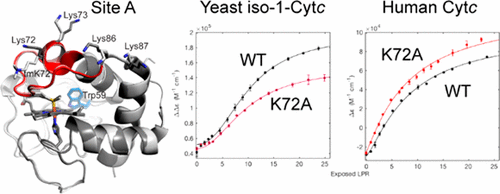当前位置:
X-MOL 学术
›
Biochemistry
›
论文详情
Our official English website, www.x-mol.net, welcomes your feedback! (Note: you will need to create a separate account there.)
Site A-Mediated Partial Unfolding of Cytochrome c on Cardiolipin Vesicles Is Species-Dependent and Does Not Require Lys72
Biochemistry ( IF 2.9 ) Pub Date : 2017-08-30 00:00:00 , DOI: 10.1021/acs.biochem.7b00694 Margaret M. Elmer-Dixon 1, 2 , Bruce E. Bowler 1, 2
Biochemistry ( IF 2.9 ) Pub Date : 2017-08-30 00:00:00 , DOI: 10.1021/acs.biochem.7b00694 Margaret M. Elmer-Dixon 1, 2 , Bruce E. Bowler 1, 2
Affiliation

|
Measurements at pH 8 allow evaluation of binding of 100% cardiolipin vesicles to site A of cytochrome c without interference from other known binding sites. Site A encompasses Lys72, Lys73, Lys86, and Lys87, located in or adjacent to Ω-loop D (residues 70–85), which positions Met80 for binding to the heme. Binding of cytochrome c to cardiolipin disrupts Met80 heme binding, permitting peroxidase activity. Binding of cardiolipin to yeast iso-1-cytochrome c versus human cytochrome c is compared to assess how binding of cardiolipin to site A has evolved for cytochrome c from species that do not have a complete intrinsic apoptotic pathway to species that do. Using a nondestructive method of quantifying cardiolipin concentration, highly reproducible binding curves are obtained. The results indicate two sequential structural rearrangements on the surface of 100% cardiolipin vesicles. The first, more modest, structural rearrangement occurs at an exposed (outer leaflet) lipid:protein ratio of 8–10 for both cytochromes c. The second, occurring at higher lipid:protein ratios, causes significant unfolding of cytochrome c and requires a much higher lipid:protein ratio for human versus yeast cytochrome c. Higher lipid:protein ratios enhance the peroxidase activity of cytochrome c, suggesting that human cytochrome c has evolved a more stringent on/off switch for cardiolipin peroxidation in the early stages of apoptosis. For both human and yeast cytochrome c, the K72A mutation has only minor effects on binding to site A, suggesting that other nearby lysines can compensate for the lack of Lys72.
中文翻译:

站点A介导的心磷脂囊泡上的细胞色素c的部分展开是物种依赖性的,不需要Lys72
在pH 8下的测量可以评估100%心磷脂小泡与细胞色素c的位点A的结合,而不受其他已知结合位点的干扰。位点A包括位于Ω环D(或残基70-85)中或附近的Lys72,Lys73,Lys86和Lys87,其位置Met80与血红素结合。细胞色素c与心磷脂的结合会破坏Met80血红素结合,从而允许过氧化物酶活性。比较心磷脂与酵母异-1-细胞色素c与人细胞色素c的结合,以评估心磷脂与位点A的结合如何演变为细胞色素c从没有完整的内在凋亡途径的物种到有的物种。使用定量心磷脂浓度的非破坏性方法,可以获得高度可复制的结合曲线。结果表明在100%心磷脂小泡表面上出现了两个连续的结构重排。两种细胞色素c的第一个更适度的结构重排发生在暴露的(外部小叶)脂质:蛋白质比率为8-10的情况下。第二种以较高的脂质:蛋白质比率出现,导致细胞色素c显着展开,并且人与酵母细胞色素c所需的脂质:蛋白质比率更高。较高的脂质:蛋白质比例可增强细胞色素c的过氧化物酶活性提示人类细胞色素c在细胞凋亡的早期阶段已经为心磷脂过氧化提供了更严格的开/关开关。对于人类和酵母细胞色素c而言,K72A突变对与位点A的结合仅产生很小的影响,这表明其他附近的赖氨酸可以弥补Lys72的缺乏。
更新日期:2017-08-31
中文翻译:

站点A介导的心磷脂囊泡上的细胞色素c的部分展开是物种依赖性的,不需要Lys72
在pH 8下的测量可以评估100%心磷脂小泡与细胞色素c的位点A的结合,而不受其他已知结合位点的干扰。位点A包括位于Ω环D(或残基70-85)中或附近的Lys72,Lys73,Lys86和Lys87,其位置Met80与血红素结合。细胞色素c与心磷脂的结合会破坏Met80血红素结合,从而允许过氧化物酶活性。比较心磷脂与酵母异-1-细胞色素c与人细胞色素c的结合,以评估心磷脂与位点A的结合如何演变为细胞色素c从没有完整的内在凋亡途径的物种到有的物种。使用定量心磷脂浓度的非破坏性方法,可以获得高度可复制的结合曲线。结果表明在100%心磷脂小泡表面上出现了两个连续的结构重排。两种细胞色素c的第一个更适度的结构重排发生在暴露的(外部小叶)脂质:蛋白质比率为8-10的情况下。第二种以较高的脂质:蛋白质比率出现,导致细胞色素c显着展开,并且人与酵母细胞色素c所需的脂质:蛋白质比率更高。较高的脂质:蛋白质比例可增强细胞色素c的过氧化物酶活性提示人类细胞色素c在细胞凋亡的早期阶段已经为心磷脂过氧化提供了更严格的开/关开关。对于人类和酵母细胞色素c而言,K72A突变对与位点A的结合仅产生很小的影响,这表明其他附近的赖氨酸可以弥补Lys72的缺乏。



























 京公网安备 11010802027423号
京公网安备 11010802027423号